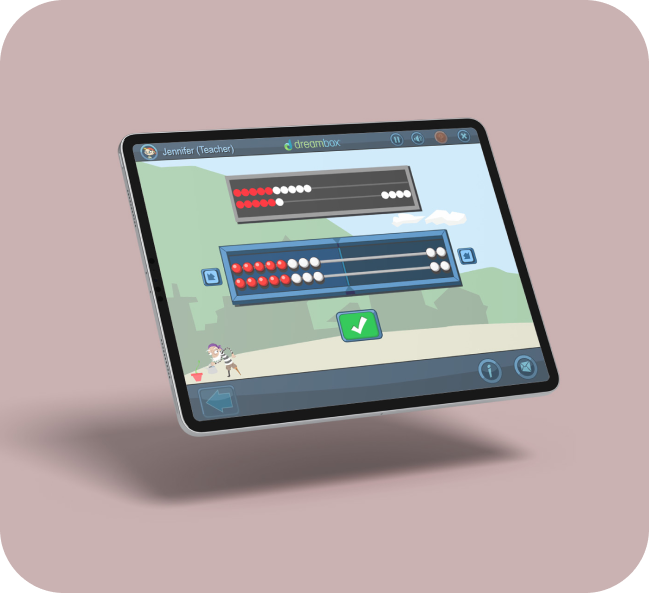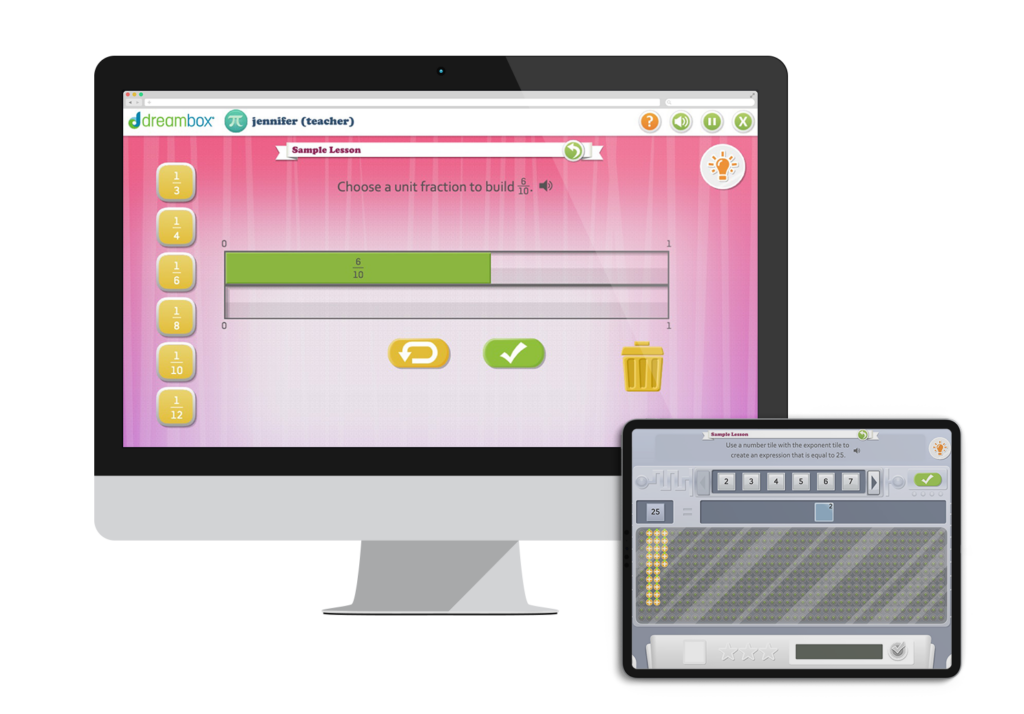In 5th grade math, students extend their understanding of important concepts introduced in earlier grades. Help your child develop their skills and confidence with this list of math problems for 5th graders.

Boost fifth grade math
skills with DreamBox
Discover an interactive math program your fifth grader will love.
Whether your fifth grader needs support or wants to master new skills, our interactive math program keeps them engaged in their learning. With interactive games and a proven curriculum, DreamBox Math helps your fifth grader boost their math skills—and their confidence.
Boost fifth grade math skills with DreamBox
Discover an interactive math program your fifth grader will love.
Whether your fifth grader needs support or wants to master new skills, our interactive math program keeps them engaged in their learning. With interactive games and a proven curriculum, DreamBox Math helps your fifth grader boost their math skills—and their confidence.

Customized learning for fifth graders
ADAPTIVE LESSONS
Each fifth grader learns differently, and DreamBox adapts in real-time to their individual needs. Whether they’re advancing quickly or need additional guidance, DreamBox creates a personalized experience that fosters progress and builds confidence.
Simple and free setup
BEGIN WITH EASE
Starting your child’s DreamBox journey is hassle-free! Start with a free 14-day trial—no credit card necessary—and see how this program is designed to help your fifth grader succeed in math.


Focused skill building
SHARPEN CERTAIN ABILITIES
Does your fifth grader excel in multiplication but struggle with geometry? With DreamBox’s assignment tool, you can track progress and assign lessons tailored to areas they struggle with. Reinforce their growth with a targeted learning approach that builds confidence and strengthens core skills.
Start your free trial
See how DreamBox can help your fifth grader with math by signing up for a free trial today.
No credit card required!
Parents and teachers love DreamBox
“If we struggle with fourth-grade fractions, we struggle with fifth-grade fractions, it just compounds. DreamBox really allows us to hone in on where we need to put in extra work.”
Stacy M.
Assistant Principal
“I am a fifth grade teacher in California and I mainly use DreamBox as a way to keep my students engaged in math when they finished with their whole group activity. It’s an early finisher activity. I really love DreamBox in the sense that it is on pace with where the students that are at, so my students who are struggling in math have the option to continue to practice their skills in an environment that they really enjoy participating in.”
Veronica S.
Teacher
“Our upper-grade teachers are noticing students are coming in with a more solid foundation of prior grade material. When our third and fourth-grade teachers have used DreamBox Math with fidelity, our fifth-grade teachers are really noticing that students are stronger with mathematical modeling than ever before.”
Carrie T.
Elementary Math Coordinator
“If we struggle with fourth-grade fractions, we struggle with fifth-grade fractions, it just compounds. DreamBox really allows us to hone in on where we need to put in extra work.”
Stacy M.
Assistant Principal
“I am a fifth grade teacher in California and I mainly use DreamBox as a way to keep my students engaged in math when they finished with their whole group activity. It’s an early finisher activity. I really love DreamBox in the sense that it is on pace with where the students that are at, so my students who are struggling in math have the option to continue to practice their skills in an environment that they really enjoy participating in.”
Veronica S.
Teacher
Benefits of DreamBox for fifth grade math
Nearly half of fifth graders in the US are falling behind in math (CRPE). DreamBox helps students get back on track by blending fun and education.
Adaptive Learning
DreamBox evolves alongside your fifth grader’s abilities, tailoring lessons to their current skill level for an individualized learning experience.
Demonstrable Progress
DreamBox delivers measurable outcomes. Students who use the program for just 30–60 minutes per week typically experience an average growth of 1.5 grade levels by the end of the school year.
Trusted and Effective
DreamBox Learning is the only dual-discipline program rated STRONG by Evidence for ESSA, demonstrating efficacy across all achievement levels and learning environments.
Designed for Fifth Graders
DreamBox captivates students with interactive games, vibrant characters, and stimulating math challenges designed to keep them motivated.
Continual Progress Updates
DreamBox tracks your child’s achievements continuously, eliminating the need for standalone placement tests. You’ll always have a detailed view of their growth.
Productive Screen Time
With entertaining, skill-focused lessons, DreamBox makes screen time a valuable opportunity for your fifth grader to learn and grow.
Adaptive Learning
DreamBox evolves alongside your fifth grader’s abilities, tailoring lessons to their current skill level for an individualized learning experience.
Demonstrable Progress
DreamBox delivers measurable outcomes. Students who use the program for just 30–60 minutes per week typically experience an average growth of 1.5 grade levels by the end of the school year.
Trusted and Effective
DreamBox Learning is the only dual-discipline program rated STRONG by Evidence for ESSA, demonstrating efficacy across all achievement levels and learning environments.
Designed for Fifth Graders
DreamBox captivates students with interactive games, vibrant characters, and stimulating math challenges designed to keep them motivated.
Continual Progress Updates
DreamBox tracks your child’s achievements continuously, eliminating the need for standalone placement tests. You’ll always have a detailed view of their growth.
Productive Screen Time
With entertaining, skill-focused lessons, DreamBox makes screen time a valuable opportunity for your fifth grader to learn and grow.
Designed for fifth graders
DreamBox captivates students with interactive games, vibrant characters, and stimulating math challenges designed to keep them motivated.
Continual progress updates
DreamBox tracks your child’s achievements continuously, eliminating the need for standalone placement tests. You’ll always have a detailed view of their growth.
Productive screen time
With entertaining, skill-focused lessons, DreamBox makes screen time a valuable opportunity for your fifth grader to learn and grow.
Adaptive learning
DreamBox evolves alongside your fifth grader’s abilities, tailoring lessons to their current skill level for an individualized learning experience.
Demonstrable progress
DreamBox delivers measurable outcomes. Students who use the program for just 30–60 minutes per week typically experience an average growth of 1.5 grade levels by the end of the school year.
Trusted and effective
DreamBox Learning is the only dual-discipline program rated STRONG by Evidence for ESSA, demonstrating efficacy across all achievement levels and learning environments.
Fifth grade curriculum alignment
Our fifth grade online math practice tool and resources are aligned with educational math standards. By the end of the school year, your fifth grader should feel confident with these key math concepts:
- Addition and Subtraction:
- Add & Subtract Decimals
- Fluency: Fractions & Decimals
- Fraction Addition
- Subtract Fractions
- Add & Subtract Fractions
- with Unlike Denominators
- Comparisons and Ordering:
- Equivalent Fractions on a Number Line
- Equivalent Fractions with Scaling Factors
- Geometry:
- Compose, Add, & Subtract Angles
- Place Value
- Rounding Rational Numbers
- Round & Compare Fractions & Decimals
- Decimal Place Value in Products & Quotients
- Decimals on a Number Line
- Multiplication and Division:
- Beyond Times Tables: Automaticity I
- Beyond Times Tables: Automaticity II
- Division to 10,000 with Remainders
- Multiplication to 100,000
- Estimate & Multiply with the Standard Algorithm
- Multiplying Decimals with Arrays
- Fraction Multiplication II
- Multiply & Divide with Decimals
- Fraction Division I
- Expressions and Equations:
- Operations Fluency 1
- Operations Fluency 2 (Parentheses)
- Order of Operations 1
- Order of Operations 2 (Parentheses)
- Translating Expressions
- Variable Expressions
- Measurement:
- Measuring and Solving for Volume
- Solving for the Volume of Prisms
- Problem Solving with Volume
Easy access anytime, anywhere
DreamBox is available on computers, laptops, and iPads through an internet browser and via our iPad app. Whether at home, in the car, or at the park, your first grader can keep practicing math wherever they are. At this time, DreamBox Math is not available on smartphones, Android tablets, or eReaders.

FAQs
Yes! DreamBox offers multiple grade levels and family plan options, making supporting your child’s math learning easier than ever.
DreamBox Math empowers fifth graders by analyzing how they approach and solve problems in each lesson. It adjusts activities to match their individual learning style, ensuring they’re consistently challenged at the right level. DreamBox monitors their progress as your child learns and grows and refines lessons to support their development. This personalized approach creates a unique learning journey tailored just for them!
Support your fifth grader by setting learning goals together! Kids love seeing their progress on DreamBox, which keeps them engaged and motivated. Start with small milestones based on lessons and then advance to focusing on mastering certain skills.
Celebrating their efforts and achievements builds their confidence. If they get frustrated, encourage persistence and discuss their learning. Simple questions like “What did you learn in math today?” can spark meaningful discussions and show your encouragement.
Track their progress with the DreamBox Family Dashboard and celebrate their achievements. You can even print certificates to commemorate milestones and celebrate their success!
No, there’s no credit card required to start a free trial with DreamBox.
Fifth grade math resources
You’ve made it – or almost made it – to the top of the elementary school mountain! As a 5th grader, you’ve come a long way in your math journey. Now’s the time where you put your math skills to the test and develop a few new tricks to get you ready for your next adventure: middle school.
Parents, if you’ve asked yourself: How will I ever be able to help my fifth grader with their math work? Here are a few suggestions to help you!
In 5th grade, students continue to develop their mathematical skills. Make practice time fun with these 5th-grade math activities!
Fifth grade math skills to practice
Learn how to multiply fractions with ease using models and repeated addition.
Dealing with fractions can be difficult, and dividing fractions is no different. Let’s learn how to divide fractions in 5 easy steps.
Knowing how to multiply decimals is a crucial skill that you’ll use throughout your daily life. Boost confidence with this step-by-step guide.
Converting units of measurement is an essential part of working with world measurement systems. Let’s learn the basics of unit conversions!
Dividing decimals can be applied to a variety of fifth-grade math problems, including dividing decimals in the form of money.
We’ll cover the basics of volume, including formulas to calculate the volume of common shapes.
Multiplication can be fun with DreamBox! Discover some of the best multiplication tips and tricks to help your child become a confident problem solver.
Master the math jargon with our A–Z of common math terms (and some handy ways to practice them!).
Division can be one of the hardest math skills to master, but it’s super important in helping your child advance to higher-level mathematics.
Every child is going to encounter word problems in maths. Here are eight steps to solving word problems from a math tutor!
If homework is a source of frustration in your home, it doesn’t have to be that way! Read on to learn effective strategies to reduce homework stress.
If homework is a source of frustration in your home, it doesn’t have to be that way! Read on to learn effective strategies to reduce homework stress.
What is mental math, and how can we use it to solve the problems in front of us? Let’s take a look!
Find other grades
If you’ve ever wondered how to help your child with math homework or what they should know by the end of fifth grade, these elementary math resources are for you.
Choose a grade level below to browse math skills and objectives by grade.
It’s time to build on what we’ve learnt so far and develop mathematical fluency.
Level up number knowledge with the introduction of multiplication, division and fractions.
Classifying, analysing and problem-solving: we’re applying all our skills here!
Understanding is extended even further across number, measurement and geometry.
Meet ratio, rational numbers and equations – this is where we explore statistical thinking.
Children learn more advanced topics like pre-algebra and investigate complex statistics and probability.
Introduce problems involving shape, scale drawings, population samples and more.




